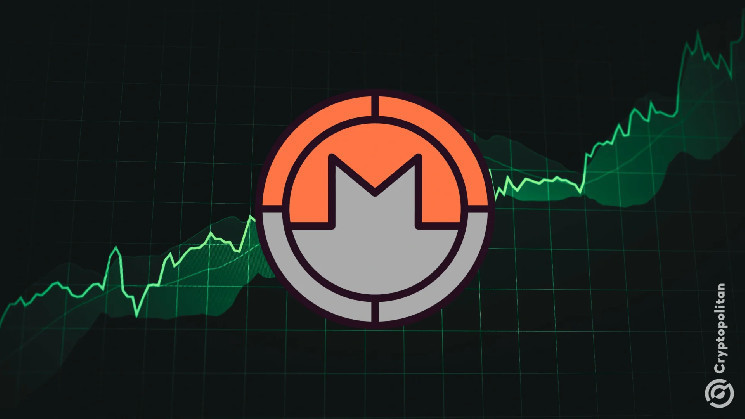ارتفعت عملة Monero (XMR) إلى أعلى مستوى لها مؤخرًا فوق 170 دولارًا. تعافى الأصل من تصحيح أغسطس عندما انخفض إلى مستوى منخفض بلغ 105 دولارات. قد تكون حركة السعر الأخيرة هذه مرتبطة بالاهتمام المتزايد بعملات الخصوصية.
يعود رمز XMR المميز، على الرغم من بعض القيود المفروضة على التداول والإدراج. تعافت XMR مؤخرًا فوق مستوى 170 دولارًا، بعد أن انخفضت إلى مستوى منخفض بلغ 105 دولارات أثناء التصحيح الأخير في أغسطس. يبدو أن العملة تعود من جديد مع عودة الاهتمام بالخصوصية.
شهدت عمليات البحث الأخيرة عن Monero ارتفاعًا كبيرًا من خط الأساس المنخفض، مما يشير إلى أن العملة قد تعيد إثارة الاتجاه.
تشهد Monero زيادة ملحوظة في الاهتمام بالبحث على مؤشرات Google. قد يشير هذا الارتفاع إلى الاهتمام المتزايد بالعملات المشفرة التي تركز على الخصوصية. قد يكون من المفيد مراقبة أي تطورات محتملة في السوق. $XMR #Monero pic.twitter.com/R5eIrnMTsp
— جون فوس (@johnfoss69) 31 أغسطس 2024
The Monero activity underscores a shift to privacy as well as mined coins and tokens. XMR is still relatively accessible to miners, keeping a baseline of 2.5GH/s to 3 GH/s based on different metrics.
Monero is already a decade old, having launched on April 18, 2014. Since then, the coin briefly traded above $1,000 before settling to its current price range between $100 and $200. XMR was considered a blue-chip asset at one point. However, it lost ground due to its confidential technology.
In the past months, Monero has been out of the mainstream crypto discussion, instead relying on its inner circle. After its delisting from Binance, XMR mostly trades on Gate.io, with some remnant activity on Kraken.
General interest in privacy coins is also a factor, as some assets may be trying to gain hashrate through hidden mining.
Monero regains exposure after improving privacy
The immediate growth of interest in Monero may be due to the recent upgrade, which made private transactions even more difficult to track. A recent update improved Monero’s vulnerability against statistical analysis. Previously, all XMR was private but limited to a group of 16 potential senders. The latest upgrade sends out proof that any of about 100,000 wallets could be a sender.
The Monero team has started to implement the privacy technology, known as Full-chain membership proof. The technology will be integrated into Monero in the coming weeks.
We're excited to share that a pull request has been made for the Full-Chain Membership Proofs (FCMP++) integration into Monero!
The pull request is a work-in-progress and will be improved upon and reviewed to ensure soundness of the implementation. https://t.co/rVysjGspQI https://t.co/nSYPNYnAhM
— Monero (XMR) (@monero) August 20, 2024
The update was first proposed in March, as a response to spam attacks that aimed to uncover some of the participating addresses.
In general, the origin of XMR has to be uncovered for centralized exchange swapping. Some protocols require a loss of privacy when selling XMR for fiat, as a way to satisfy exchange KYC requirements.
The popularity of XMR also rose after the recent arrest of Pavel Durov, co-founder of Telegram. The need for privacy is still one of the main goals for part of the crypto community, despite calls to de-anonymize some assets for legal purposes.
Monero users can also choose to reveal their identities, using the coin for payments even on social media handles. XMR has been used as a tipping coin between accounts on X.
Did you know all you need to do is pin your @monero $XMR address to your profile and users of @cakewallet can send payments to you via your X handle also allowing them to verify you as the receiver? Nice and easy. Keep up the great work @cakewallet https://t.co/GefXVVxFE7
— Jason Henson (@A_Jason_Henson) September 1, 2024
The Monero community pointed out the recent spike in searches is an accidental word-of-mouth event. The searches may be related to an online quiz question on Monero. However, in August, an even bigger search spike was seen for “XMR”, suggesting interest in the crypto coin itself. This uptick is also reflected in recent trading activity.
Monero still upgrades its protocol through hard forks, where all nodes need to run a new version. The Monero network has grown to 4,600 active nodes worldwide, with up to 13,000 nodes online during busier days.
Monero users have complained that the coin is harder to adopt in comparison to modern tokens. Monero wallets still need synchronization to display balances, sometimes requiring hours of activity. Additionally, buying XMR is not straightforward for new users.
Can XMR break out to a higher level?
Monero’s fame seems to be growing. Perhaps, it has an opportunity to become the top privacy coin in an eventual bull market. XMR is gaining attention, despite the competition from older assets like ZCash (ZEC) or newly launched privacy coins Xelis (XEL) and DERO.
XMR has legacy status and may re-spark interest faster due to better available liquidity. XMR trading still sees $65B in daily volumes, with 82% against Tether (USDT). XMR also has a direct market against the USD, making up 8% of all activity.
Chart analysts see XMR as potentially breaking out, despite the overall subdued sentiment on the rest of the market. XMR extended its recent gains, while its main competitor, ZCash (ZEC) slid from $40 to $30 within days.
XMR has been drifting sideways for months, once again setting expectations for a breakout to a higher price range. The inflow of USDT may help XMR if market sentiment shifts and funds flow to new types of assets, returning to the stars from previous bull markets.
Cryptopolitan reporting by Hristina Vasileva
